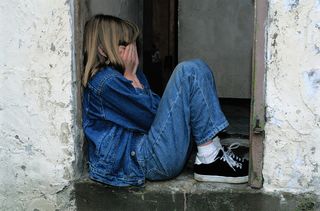Divorce
Shared Physical Custody–What Children Discover and Suffer
A new perspective on 50/50 arrangements reveals eye-opening effects on children.
Posted September 19, 2019 Reviewed by Davia Sills
What Do Children Learn From Joint Physical Custody?
With a parental and judicial focus on “fairness,” children discover they must surrender to this “fairness” standard. They must do whatever they are told is “fair”—half-time with Dad and half-time with Mom; see Dad the same amount of time as they see Mom; live at Mom’s house the same amount of time they live at Dad’s house.
Children learn to ignore and subordinate their emotional and developmental needs and defer to parents’ and judicial wants and needs for this “fairness.” Each child realizes they must endure the difficulties, and sometimes-downright chaos, of alternate living in two places and solo with two different adults.

Children eventually discover they will have their emotional and physical needs met best by only one parent. Commonly they will be more relaxed being a child with that parent. With the other parent, they discover they must function in psychologically inappropriate ways.
This is not newly occurring in divorce, but children must negotiate with each parent separately from when they all lived together. This is more difficult.
Children will be called upon to tend emotionally to this parent in a role-reversal manner. With this parent, they often feel overwhelmed, tense, anxious, and fearful. They worry whether this parent will make ball practice on time, whether they’ll have a clean uniform and money for lunch or a packed lunch to take to school. They learn they are supposed to surrender to the parents’ and court’s desire for their lodging in alternate households, no matter how tumultuous the process or what they suffer emotionally.
The Emotional Fallout for Children
In my experience, children feel tremendous expectations to please at least one parent—commonly the emotionally helpless or impotent personality ones—the parents who want their own emotional well-being met by their children. Homer B. Martin, M.D., and I explain how impotent personality parents create these types of role-reversed relationships with their children in our book, Living on Automatic.
The children describe feeling pressured emotionally. Often they become emotionally and physically overwhelmed and exhausted. They suffer from anxiety, depression, academic failure, self-devaluation, and reduced self-esteem. In adolescence, they may become substance abusers or attempt suicide.
What specifically is children’s emotional distress due to?
Part of their suffering and symptoms are due to the continual physical relocation of living in two very different households. Where’s my stuff? Why won’t Dad make meals rather than getting fast food all the time? Who will pick me up today?
Another reason for emotional upset and illness is the child’s not being able to please the parent that most wants 50/50 living arrangements. The message from this parent to his or her child is, “Put my emotional needs first.” When a child finds he or she is unable to fulfill this parent’s needs, the child becomes anxious and depressed and believes she is a failure or a bad person.

The emotional pressure to please this parent and failure to do so sets up the child for self-devaluation that may even result in feeling suicidal. Children experience the quandary: Who do they care for the most—this parent or themselves? They feel guilty when they try and save themselves and live as children, and not as a parent to one of their parents.
Beyond 50/50 Split Custody
Not all children in split physical custody show overt symptoms of emotional distress. Some cope better, but still show subtle emotional effects that affect their lives and relationships as they grow older. Many have told me they feel rootless with no one place to call home. Others disclose their unsettled feelings with the constant hubbub of moving back and forth and resign themselves to always feeling disorganized. As adults, they find themselves tolerating repeated similar feelings of emotional turmoil and repeated physical relocations in their own marriages and divorces.
Some professional literature indicates children fare better in a one-parent living arrangement with frequent visitation with the other parent. The difficulty for courts and parents is determining which parent offers the parent-caring-for-child scenario and not the child-caring-for-parent scenario. This determination stymies both the court system as well as most parents.
Commonly, in time, the more caregiving parent figures out the situation after observing the children go back and forth between households and witnessing the emotional and behavioral changes in their children. But, in my experience, this parent has a difficult time convincing a court system dedicated to “fairness” through its 50/50 shared parenting decisions.
Sometimes children put their own foot down with parents and judges. They create their own design to live with their more caregiving parent or to reduce time with the other parent. This is common with teenagers, who crave some settledness and control in order to have a social life with other teens. In my experience, this happens more often with children in psychotherapy who explore themselves and get a clearer understanding of the effects of 50/50 shared custody and the emotional burden of psychologically trying to care for one parent.
I recall a child in psychotherapy, about 10 years old, testifying in court about wanting to live full time with one of her parents. This was not a case of parental alienation, just a child fed up with caring for one parent and enduring the chaos brought on by that parent. She told the judge this was her idea.
The judge reminded the girl she had ordered 50/50 shared custody, not sole custody. While trembling and becoming teary-eyed, the very brave girl asked the judge, “What are you going to do to me if I won’t do it? Put me in jail?” Only then did the judge reconsider and allow the girl to live with the parent she wanted.
Children always become attached to both parents, but their attachments are different in type and scope. In a divorce, the question is, who can best raise children to adulthood, giving necessary care in developmentally appropriate ways? Seldom can both parents do this equally well. One will be better at this task than the other.
Because of this difference among most parents who divorce, as a child psychiatrist, I recommend children live with the parent who does the most and best caregiving. And, of course, children should also have a robust relationship visiting with their other parent.
References
The High-Conflict Custody Battle: Protect Yourself and Your Kids from a Toxic Divorce, False Accusations, and Parental Alienation by Baker PhD, Amy J. L., Bone PhD, J. Michael, et al., New Harbinger Publications, 2014.
Divorce Poison New and Updated Edition: How to Protect Your Family from Bad-mouthing and Brainwashing by Dr. Richard A. Warshak, William Morrow Paperbacks, 2010.
Surviving The Breakup: How Children And Parents Cope With Divorce by Judith S. Wallerstein and Joan B. Kelly, Basic Books, 1996.




